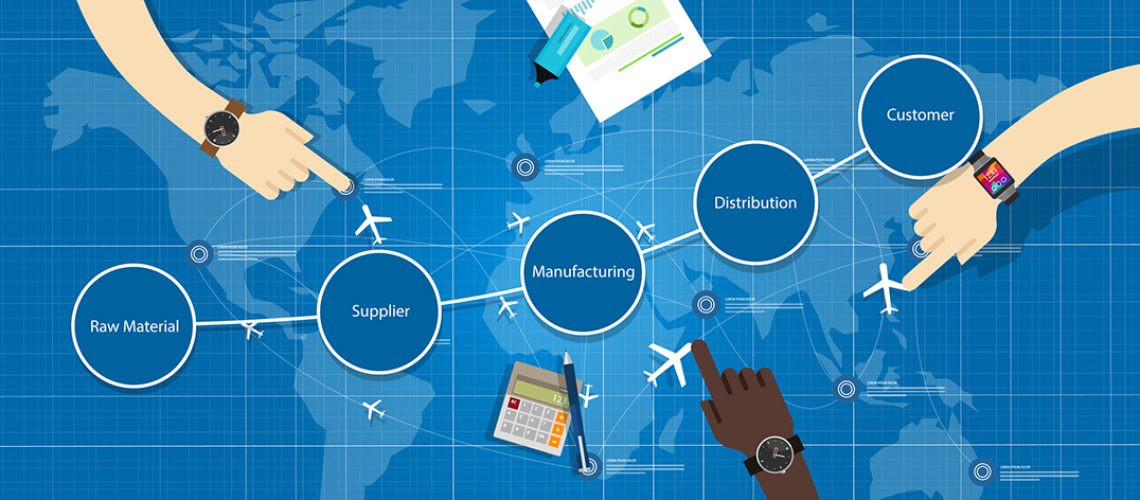Supply Chain before Blockchain
Since the beginning of human civilization, supply chain has been a part of our lives in some form or other. In simple terms, a supply chain is everything related to moving a product/service from the producer to the consumer. We are essentially dealing with spatial-temporal data, which means that we need to track information on where and when. For a long time, the so called ‘chain’ in supply chain was short, consisting of only few entities. Now with the internet bringing the globalization to the game, supply chains are no longer localized, they are globalized. In old days, you know the apple you bought came from a farmer in your village, but now that apple might have been harvested 10,000 miles away and has traveled half way around the world changing hands numerous times.
This brings forth many challenges and difficulties. One major challenge is that the consumer no longer feels safe buying things (especially food) when they do not have a way to verify where it has been and under what conditions. With the access to smart phones, now everyone is in an instant information era, therefore a consumer is not willing to talk with the store owner and find out things. What is expected is one click information. This leads to the second challenge; not having a trusted and coherent documentation process through the supply chain.
In practice, we cannot expect everyone in the supply chain to follow the same set of documentation process. Most of the time the first exchange in the chain (say, famer to the local collector) happens on a cash basis. May be a receipt will be provided. But very rarely they are being added to electronic storages. This provides the opportunity of fraud or information corruption. The local collector can change the prices, harvest dates, etc.
The third challenge is that even if a certain company gets their entire supply chain to follow a coherent documentation of the transactions, still the information is on the company’s server. How can a consumer trust the information when it is evident that the company could have easily changed the details of the product history. (e.g.: Changing the harvested date of a batch of organic food).
Introducing Blockchain
Now how does Blockchain fit in here? First, what is a Blockchain? Well, in simple terms, it is an electronic ledger which is constructed as a chain of blocks where each block represents a transaction/event that occurred. You may wonder, if it’s a ledger, don’t we face the same set of issues as we did before. The answer is No. The Blockchain is constructed in such a way that when a block (transaction) is recorded, it is immutable; meaning that it can never be changed, by anyone. A transaction cannot be deleted either. This provides the information in the chain with the integrity of being tamper proofed.
How is this possible, you may wonder? Can’t the company who owns the chain change it, after all it’s all 1s and 0s? Well, that’s the beauty of decentralized part of the Blockchain. The chain doesn’t live on one location, it lives on the nodes (servers) of the entire network. Therefore, trying to make a change to one copy on one server will not have any effect since everyone else’s copies of the ledger are intact.
This provides a major advantage over the conventional networks. The participants no longer need to trust one another or trust a third-party middle man entity. Now they can trust the collective nature of the network. No one can exploit the inherent trust of the system since everyone has a copy of the ledger.
Now you may still wonder, if the ledger is shared with everyone in the network, does that mean everyone has a copy of my data and everyone can see my data? No, of cause not. If its sensitive information, then they can be saved on one’s personal wallet and have a record of the validity of that data on the chain or can save the transactions on the chain itself and provide permission-based access. For the scenario of the supply chain, it’s important that the information is accessible (with permission) by different entities on the chain. When it comes to other solutions such as identity and personal data, Blockchain provides the luxury of saving them on the owner’s wallet and that wallet only.
Transactions and Blockchain
So how does a transaction get inserted into the chain? Let’s take the supply chain scenario of importing apples from somewhere. The local agent would go to the farmer and buy the apples. At this point a smart contract will execute linking the farmer and the local agent. This automatic execution of the smart contract might do something like, deducting certain dollar amount from local agent’s account, adding that amount to farmer’s account, register the time, location, number of apples, their conditions (via sensors if available on the crate), etc. And all this information will be put into the block chain as a block which can never be changed.
Now the apple exporter, who buys from the local agent, doesn’t have to take the word of the local agent on when he bought the apples and at what temperature and conditions they were in, how long they were stored, etc. It’s all in the chain now. Same thing with the importer on another country who previously had to take the word of the exporter (or the documentations which can be faked) on the amounts, conditions, origins, etc. of the food. Previously, the importer couldn’t be sure of the condition under which the apples were in throughout its journey through the supply chain. But now since everything is permanently registered on the chain, everything can be backtracked if needed.
Since the information is in the chain all the way from the harvested point, it’s very easy to provide the end consumer with quick and full information. On the supermarket shelve, the consumer only has to use the smart phone to scan a serial number or a QR code and all the necessary information will be available, including where the apple was grown, when it was harvested, when it was shipped, where it was stored, under what conditions were they handled, how much time has passed from harvesting to now, etc. And consumer no longer has to worry about whether the supermarket owner has changed the details, because it can’t be changed.
As you have seen, Blockchain brings two major features to play when considering supply chain; process optimization and data visibility (data integrity). With every transaction/event being recorded in such a way that it cannot be changed, the auditing and analysis is efficient and accurate. This makes way to finding the inefficiencies, fraud, malpractices, etc. thus leading to better process optimization while the visibility of data provides the opportunity of collaborating with entities whom which we don’t inherently trust, but through the trust on the chain, business can be conducted without conflict.
To read more about Blockchain and supply chain, check the Wikipedia page here https://en.wikipedia.org/wiki/Blockchain
Deep Data Insight are Artificial Intelligence and Machine Learning specialists. To get in touch about your project, click here https://www.deepdatainsight.com/contact/


